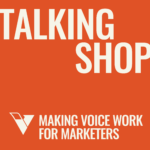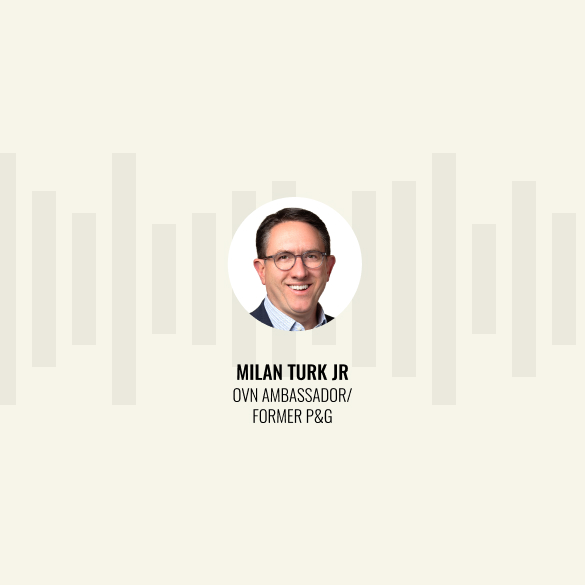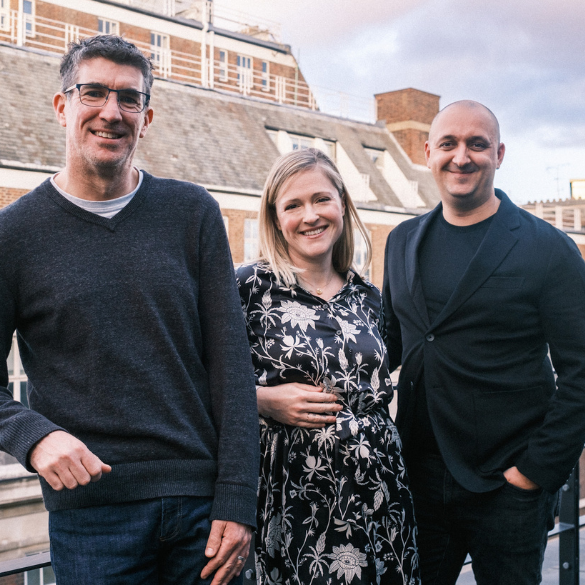
Listen to Talking Shop Episode 8
Listen to Episode 8 of Talking Shop: Making Voice Work for Marketers right here. Talking Shop is a brand new podcast series from Vixen Labs, taking you through the core findings and insights from the Voice Consumer Index 2021.
This is the last episode in the VCI 2021 series of our podcast! If you haven’t yet, make sure to catch up on all eight episodes. This one tackles voice usage in the FMCG/CPG industry with former Executive at Procter & Gamble Milan Turk. Tune in!
Or read the transcript
James Poulter 0:00
Hello, and welcome back to another episode of Talking Shop. I’m your host, James Poulter. And in this episode, we’re going to be digging into the world of consumer packaged goods — that’s CPG for those friends on the US side of the pond, and for those of us over in the UK and Europe, you often think of this as fast moving consumer goods or FMCG. The acronyms aside, it’s all about the things that we buy every day and every week to keep our households moving, and the things that keep the majority of the voice economy moving as well.
James Poulter 0:29
In this episode, we’ve got a fantastic interview from Suze Cooper, our Audio Strategist here at Vixen, with Milan Turk, an ex-Executive from the world of consumer goods, in particular from Procter & Gamble, where he has spent nearly 36 years working as an executive there in many different roles and fields. And in this episode, they get into talking a little bit more about the world of consumer goods, and the impact that voice is having on the e-commerce and bricks and mortar trade around the world. So you’re in for a treat. I hope you enjoy this episode. I’m gonna hand it over now to our Producer Suze, as she talks to Milan Turk, Executive and member of the Open Voice Network.
Suze Cooper 1:06
Milan, thank you so much for joining us here on Talking Shop today. It’s so great to have you here with us. So, if you could just start really by explaining your background in CPG, and your interest in voice as an ambassador for the OVN.
Milan Turk 1:20
Of course. Thanks, Suze. So, Milan Turk, and I come to this meeting today as a CPG Executive, retired. I worked for Procter and Gamble in the United States and all around the world for 36 years. And I stepped away from that. I graduated, as I say, in the summer of 2020. And I had already become very involved with the Open Voice Network in my role leading the future of shopping, future of retail and future of selling initiatives at P&G, in my last role there. And I continued on working with OVN as a community builder and ambassador of the important messages and opportunities that it represents. I really like all things CPG, I like understanding what consumers are thinking about. I spend a little bit too much time in grocery stores as a result, or online shopping. But it’s all good.
Suze Cooper 2:30
So let’s start out with a fairly broad question, then, what is the opportunity to market FMCG/CPG brands via voice?
Milan Turk 2:39
Super, let’s get the basics right. You know, the human basically has a variety of input and output capabilities. And for FMCG, who is always trying to connect and build a relationship with a consumer, it’s really important to understand how that consumer relates to the messages the brands are offering. Now the fastest connection for a human brain is the eyes. You’re going to see something, it’s almost like being hardwired into the message, it goes straight to your brain through the optic nerve. But the second fastest entry into your brain is sound. And we, as a species, have evolved over these thousands of years, communicating, hopefully well, with one another.
Milan Turk 3:34
And we do that through voice and other sounds. Everybody knows what a warning siren is. I mean, your brain interprets sound, and quickly understands messages that way.
“WHAT A GREAT OPPORTUNITY, ALL OF A SUDDEN FOR FMCG BRANDS, OR BRANDS IN GENERAL, TO HAVE LITERALLY A VOICE TO COMMUNICATE WITH A CONSUMER.“
Or, as I often say, in the act of shopping, the shopper, who’s looking for information who’s trying to make a choice…So, if you’re trying to have a relationship with someone, and, while visual might be the best, voice is a close second in terms of really penetrating the thinking of of the shopper. So it’s a terrific opportunity. Done well. Done right. It’s a great opportunity.
Suze Cooper 4:30
So, now, voice needs trust, you know, you’re having a conversation with a brand essentially. Do you think that these big CPG brands that we hear about have got that personal touch when it comes to the consumer relationship? And, if not, do you think, perhaps, there needs to be a change of perspective when it comes to voice innovation, maybe?
Milan Turk 4:54
I think brand, branded goods companies would be the first ones to tell you, and as a former branded goods Executive, you know, we would be the first to tell you that trust is of the utmost importance. It’s, I’m certain, it’s number one priority on most branded manufacturers lists of priorities, trust with the consumer. The thing about that is, we’ve done research for decades about…what are the jobs the consumer is trying to do? What are the things that matter most? We capture insights about their lives so that our messages are more relatable. But the question you’re asking about trust is a little bit different, which is not just: are we giving trustworthy messages? You’re asking the question about, with the integration of technology into this conversation, if you will, can a consumer trust what we’re doing with their information, what we’re doing with their voice.
Milan Turk 6:02
Or if we’re even answering the questions that they have reliably, as we seek to present the answers back to them in a voice, and interface with them as they ask their questions with their own voice. So it’s a whole new aspect of trust. It’s not just about building a relationship that indicates we care and understand them. It’s about whether they can reliably assume that the information coming back to them is accurate, or is it simply just what’s at hand via the technology being connected. And secondly, they obviously have a great deal of concern about whether they’re being listened to, which is another aspect of the technology. And whether their own characteristics, which are communicated via this very personal thing called their voice, is being managed, well kept confidential, only being used in the way they intended it to. So it’s an entirely new set of questions about trust in an industry that has already cared deeply about trust for a long time.
Suze Cooper 7:25
Great answer, fantastic answer. The Voice Consumer Index research shows the top three priority tasks in this sector using voice are package tracking, researching a product and placing an order. And the research also showed that people are starting to purchase via voice on a more regular basis. So where do you see voice purchases as being most effective for CPG brands?
Milan Turk 7:47
Well, the first reaction I had to the research insights you just shared — and it’s not a direct answer to your question, but I’ll get to that — the first really interesting thing was how similar the three highlighted countries actually were, in the way consumers begin to use voice. So the United States, the UK, Germany, we have our differences. We have different cultures, we have different shopping habits. But, look, what became clear is researching purchases, checking on where my packages are and answering questions about my purchase. These were the top uses in maybe in a different order, but in all three cultures and countries, consumers are gravitating towards the same thing.
Milan Turk 8:34
My theory on that is that, instead of just looking at which questions did they answer, go a bit to the cognitive level.
“WHAT CONSUMERS ARE TRYING TO DO IS MAKE THINGS EASIER FOR THEMSELVES. AND VOICE IS A NATURAL WAY TO MAKE THINGS EASIER.”
I sort of already talked about, you know, visual through your eyes is the fastest way to your brain, but through your ears is the second fastest. And the natural reaction to what goes in your ears is to talk. So, if you’re a consumer or a shopper, and you’re, particularly in these days, where you have so many extra things to worry about. You’re just looking for ways to reduce the cognitive load that comes from, let’s say, shopping. What’s on my grocery list? Where can I get it? Where can I get it faster? Didn’t I already order that? When is it going to show up at my house, you’re looking for things to be easier.
Milan Turk 9:37
You’re delighted with the idea that, instead of using a lot of brain cells, you can just go to that very quick thing that we’ve all been given, which is I’ll just ask a question. I’ll just ask, and whether, you know, you have a variety of platforms at your disposal these days, but you can simply ask: ‘Where is that thing I ordered?’ So I’m really not surprised at what ranks highly, because all the questions that rank highly are basically things about make my life easier, make my life easier by just giving me the information so I can make a better choice or move on to something else.
Suze Cooper 10:15
Sure. And consumer goods and grocery shopping have really been a core of kind of voice commerce up until now. There are more options coming online, we’ve got Send to Phone with Alexa and other technology coming on stream, do you think that voice is a buying channel has got a strong future?
Milan Turk 10:33
I do think it has a strong future. Because voice is such a natural interface for the human species. Whether you’re an introvert, whether you’re an extrovert, you are trained from birth to speak or voice or make some sound indicating what it is you want. And, you know, in today’s world, shopping is basically a form of gratification.
Milan Turk 10:57
So, asking for something that you want and searching for it. And using your voice is almost a natural. I’m not a scientist, and I’m not offering here a new theory on this as being part of human evolution. But it does seem to make sense that we, as a species, talk about things we want. And we tell other people what we want. So having now the ability to tell machines what we want, it seems like it’s only going to accelerate and grow bigger, which of course, returns the pressure on this notion of trust, and makes it so important that we, as an industry, you know, move forward in a collaborative way to create the capability.
Suze Cooper 11:43
So, for brands, there must be quite a challenge of being that one that makes the sale via voice, right? Because there’s a potential here for like repeat buying where it’s easy, as you say, it’s easy to ask for things, it’s easier just to say ‘yeah, I want to buy that again’ than it is to go through kind of the whole rigmarole of choosing which it is that you want. Overcoming that challenge of being the one that answers the question, how can brands tackle that?
Milan Turk 12:13
I like your very technical shopping term ‘rigmarole’. I mean, you’re you know, ‘rigamarole’ is basically the technical term for ‘wow, it’s too hard, can you make it easier for me?’, and I completely agree with you that the idea of ‘send me what I bought last time’ is, you know, probably the easiest way of repeat purchase. A lot of the techniques that have been used in the past of branded goods marketing will continue to be used just in the new medium of voice. So, the idea that…let’s take toothpaste dentifrice, you know, we can come up with word association for which words are most important — white, clean, fresh breath, expressions like that.
Milan Turk 13:05
So, you know, you might be forming a mental picture of print advertising in the 60s or 70s that used those words, you might be forming a mental picture as you hear this, of search terms that were used in the early 2000s, that people type in. And as they search for their…it, hopefully, becomes their favourite toothpaste purchase. But, in many ways, voice is going to be the same way. Probably the brain is going to generate more things to say. And so, the technology, the recognition of terms, if you will, in the voice technology is going to have to be broader than it was in simple typed in search terms.
Milan Turk 13:53
But that’s a great place to start. Does the technology work? Well, when it comes to recognising what people say about the brands? Or the brands that are looking for, or the jobs they need to have taken care of? Artificial intelligence…if somebody says ‘how can I freshen my breath?’, the technology may be able to realise that that’s actually a question about looking for toothpaste. That’ll be an important sort of thing when it comes to: does the technology work at a level that people will say ‘oh, it really does work, I’m going to use it more often.’ I think we sign the research. You know, the more complex the question becomes, the less there is a rate of adoption, and that’s probably because the terminology used to get the answer you want is more complicated and the technology of voice recognition may not work quite as well yet.
Suze Cooper 14:55
And, I think it’s probably worth explaining. It’s not just about brands having their own, say, Alexa skill or Google Action. You know, there’s certain elements that can be looked at now that brands might potentially be needing to have a look at, like, voice activating their website, those different elements, those digital touch points they’ve already got. You know, what needs to be thought through there, really, for these brands?
Milan Turk 15:21
Oh, that’s a great question. Because there’s, there’s quite a few things. Actually, I think one of the first things that had a big impact in my career, as we began to involve…explore voice, was not just to call it voice, but to think of the end being commerce. So we were, you know, we were focused on ultimately that somebody wanted a good or a service that they were going to buy. And we called it conversational commerce. And we realised that there are actually several forms of conversational commerce, they don’t all just involve talking to a device on your countertop or into your phone, you may be doing a chat bot or a chat room, or some sort of…even typing in a conversation is a…is contributing to the technology and effectiveness that will ultimately be voice.
Milan Turk 16:22
So, it’s really about how humans communicate by conversation. And brands should be thinking about that bigger picture as part of their game plan. Another super important part of the game plan, if you will, for ultimately having success in voice is: are there standards in place? Now, standards will help you organise your information, they’ll help you understand what the state of capability is. And, in almost any industry initiative that I’ve been a part of in the last 20 years, understanding standards — and, just to be specific, what I’m talking about is, like, standards in how voice interfaces work, standards in terms of how you create wake words, or words that activate devices, these sorts of things.
Milan Turk 17:18
Putting these standards in place will ultimately help the whole industry accelerate. And it will certainly benefit the consumer, because consumers will buy different devices that they will use to interface with their voice. An organisation like the Open Voice Network is looking hard at how standards are developed. And they’re convening players, technology players, brand owners, even groups that represent the concerns of shoppers about things like trust, they’re convening these groups together, to identify and organise the challenges, so that they can be addressed. And that they can be prioritised and worked through in a collaborative way. That’s really a typical blueprint for an initiative that is trying to bring a complex technology-based capability to market to respond to the emotional, and very human user requirements of shoppers. That’s, you know, you… it’s kind of like addressing an emotional need with a very hard-edged technical solution. It’s not the most obvious thing, it requires organisation. And if one of the goals is actually trust, then you need some organisation, and a group like the Open Voice Network to bring it all together. That’s been my experience.
Suze Cooper 18:48
Absolutely. I think the more voices that are there within the OVN, don’t pardon the pun, because it was meant, the better in terms of the standards that will come out of the other side of it. And, the more useful they will be across the board for the various sectors all the way through.
Milan Turk 19:03
Yeah, very clever. I completely agree.
Suze Cooper 19:05
So, Milan, you spent over 20 years at Procter & Gamble, you must have seen quite a lot of technology change during that time. What makes you so bullish on the future of voice technology for consumers?
Milan Turk 19:18
Plain and simple, that it’s an extremely human experience to have a voice conversation. I think since many of us were kids, we probably saw, I don’t know, 2001 A Space Odyssey or Star Trek, where literally, the voice was addressed as a computer and that was fantasy. But, you know, that fantasy or that creativity had at its core insight. The idea that humans like to communicate using their voice. That’s the first thing we learned to do when we’re a child, we cry out for help.
Milan Turk 20:01
And so, you know, will there be something that comes after voice interface? I suspect there will be direct machine brain interface. Great. We can talk that on a podcast here a couple years from now.
“RIGHT NOW, THE INCREDIBLE PROMISE IS THAT THE PRIMARY MEANS OF HUMAN COMMUNICATION, VOICE, IS GOING TO BE LEVERAGED AS AN INTERFACE, WITH THE INCREDIBLY ENABLING AND BENEFICIAL TECHNOLOGY, DIGITAL TECHNOLOGY.“
Another feature of the whole thing is that, because it does address so clearly a deep human insight, like, how humans communicate, it just exponentially raises the bar on the level of responsibility to get trust right. Standards, right. So that there can be more players in the industry, that the needs of the entire human community can be addressed. It…the deeper you go into the human insight aspect of it, the higher the level of responsibility, in my opinion, to get the trust and the standards right to be more inclusive.
Suze Cooper 21:15
Just before we finish up, people will sometimes say, you know, ‘how can you buy a pair of trainers via voice without knowing what they look like?’ Voice doesn’t have to just sit alone. Yes, we get that great connection from speaking and listening, but, sometimes, there is also that element of visual that might be needed, perhaps, when buying these different items and goods.
Milan Turk 21:39
Yeah, well, you know, think about it. A lot of what we’ve said here today is about how technology becomes more accommodating to the ways humans like to communicate. And, all of a sudden, you have voice as a method. But, you know, when you go out to a party, you don’t all put on blinders and eliminate your visual capabilities. Or, you know, I know there are restaurants that you dine in the dark just to accentuate one sense, your taste, but that’s a very limited sort of thing, focusing on one sense.
“THE FULLER HUMAN EXPERIENCE IS ABSOLUTELY MULTIMODAL — SOMETHING YOU SEE WITH YOUR EYES, SOMETHING YOU COMMUNICATE USING YOUR VOICE.”
I suspect, I guess I am already aware of capabilities that, digitally, can offer you smell or touch, as well. And I think that’s definitely the future. I think that if we’re drawing the curve of responsibility for standards and trust, you know, the more modes you add, probably the higher the bar is set for trust and things like that.
Milan Turk 23:00
But, yes, I think today you already are witnessing people probably in your supermarket or other shopping experiences, looking at a shelf and talking to their phone, or looking to the shelf, in some places, talking to the shelf. Looking at the shelf, talking to the shelf, and picking up items, and feeling them, and touching them, and selecting them. The addition of more senses to the experience is…seems certain to me.
Suze Cooper 23:33
Yeah, certainly reinventing the shopping experience as we’ve known that up until now, I think. Milan, thanks so much for giving us your time today. It’s been great to chat to you here, on Talking Shop. Hopefully we’ll talk to you again soon.
Milan Turk 23:44
I appreciate it. Let’s go shopping together soon. Thanks, Suze.





